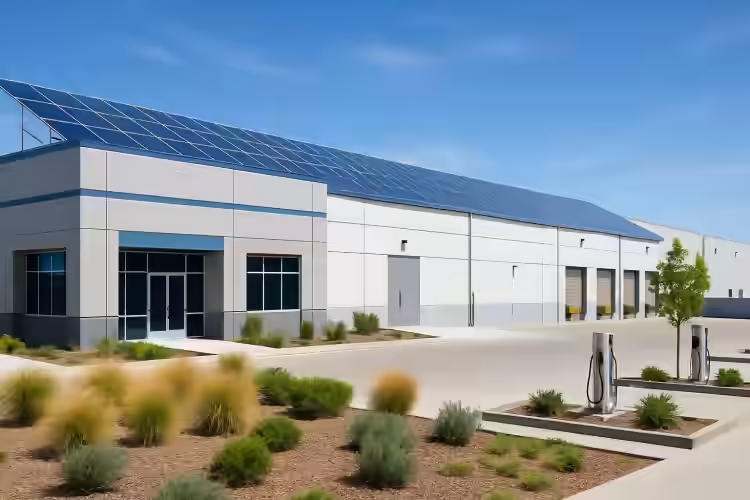What Is ESG and Why Should You Care?
ESG—short for Environmental, Social, and Governance—isn't just another business buzzword. It's how companies are being judged (and funded) in today’s world.
If you’re leasing, managing, or designing a warehouse, ESG matters. A lot.
Why? Because stakeholders are asking harder questions:
- Is your energy footprint shrinking?
- Are you treating employees and the community right?
- Is your building ready for the next 10 years—or just barely hanging on?
If you’re shopping for warehouse space—or getting ready to build—knowing the latest in sustainable design isn’t just trendy. It’s smart business.
Why Warehouses Are Key to ESG Goals
Warehouses chew up space. And energy. And a fair bit of concrete.
We’re talking 100,000+ sq ft facilities—sometimes several football fields wide. In Riverside, California, there are industrial hubs you can see from the sky. Same in Dallas, Texas, and Chicago, Illinois.
These aren't just storage boxes—they're ecosystems. They use lighting, HVAC, forklifts, shipping equipment… and often run 24/7.
So naturally, they’re also ground zero for sustainability efforts.
The good news? Warehouses are some of the easiest commercial buildings to make green. Lots of roof space. Large, open interiors. And long-term leases that make upgrades worth it.
Trending Sustainable Warehouse Design Features
Here’s what’s hot (and honestly, what’s practical too):
1. Solar-Ready Roofs
Big roofs + long sunlight hours = solar goldmine.
In places like Phoenix, Arizona or Las Vegas, Nevada, some warehouses are offsetting over 50% of their electricity use with rooftop solar arrays.
Even better? Many landlords now offer Power Purchase Agreements (PPAs) so tenants get cheaper electricity without fronting the install costs.
2. LED & Motion Lighting
Old warehouse lighting systems are power hogs. LED retrofits save 40–60% on lighting costs—and last way longer.
Bonus: motion sensors reduce unnecessary burn time. Lights on only when you need ’em.
3. Cool Roofing Materials
Bright, reflective roofing cuts indoor temps in hot states like Houston, Texas. That means less AC usage—and happier workers.
4. Energy-Efficient HVAC and Dock Seals
HVAC might not seem like a big deal in a warehouse. But in operations with food, pharmaceuticals, or electronics, it's huge.
And dock doors? That’s a leak zone. Better seals = better thermal control.
5. Water Conservation Features
Low-flow fixtures, native landscaping, and smart irrigation save thousands of gallons. Not glamorous, but wildly effective.
Tech and Tools Powering the Green Warehouse Movement
It’s not just bricks and steel anymore. Smart tech is leading the ESG charge.
Building Management Systems (BMS)
These are the brains of the operation. They automate lighting, HVAC, energy usage—and give you dashboards to see what’s working (or not).
Smart Meters
Real-time energy and water tracking. Great for pinpointing inefficiencies and optimizing performance.
IoT Sensors
Got forklifts idling too long? Areas of the warehouse staying lit when empty? Sensors tell the story—and help fix it.
EV Infrastructure
As delivery fleets go electric, warehouses need to keep up. Charging stations for vans and trucks are a growing must-have.
Sustainability ROI: Does It Pay Off?
Short answer: Yep.
Longer answer? Sustainable upgrades often pay for themselves in 3–7 years.
Energy savings alone can shave 10–30% off utility bills. And depending on the city or state, you may qualify for green tax incentives, rebates, or fast-track permitting.
In Portland, Oregon, for example, green buildings can get up to 30% off development fees. Same goes for LEED-certified spaces in Boston, Massachusetts.
Plus, ESG-forward warehouses tend to attract better tenants—and command higher rents. Think long-term value, not just upfront cost.
Examples from the Field: Warehouses Going Green
Case Study 1 – Southern California
A 200,000 sq ft distribution center in Ontario, California installed solar panels, upgraded to motion-LED lighting, and earned LEED Gold certification.
They cut their energy bill in half. Half.
Case Study 2 – Midwest Cold Storage
A facility near Columbus, Ohio needed serious HVAC upgrades. They swapped old chillers for variable-speed systems and added dock shelters.
Result? 35% energy savings during peak months.
Case Study 3 – Spec Build in Austin, Texas
This new build didn’t just check ESG boxes—it made them a selling point. Smart meters, cool roofing, EV chargers, and native landscaping helped it lease out 3 months faster than comps.
What’s Next in Sustainable Design?
We’re seeing exciting trends on the horizon:
- Green Roofs: Not just for city buildings anymore. Some warehouses are installing rooftop gardens to offset heat and improve insulation.
- Carbon-Neutral Materials: Recycled steel, low-emission concrete—these are becoming standard in future-forward builds.
- Modular Walls & Offices: Spaces that can flex and change with tenant needs, reducing waste and future build-out emissions.
- On-Site Battery Storage: Store excess solar energy. Avoid demand surcharges. Super relevant in peak-grid areas.
Final Thoughts: Green Isn’t Just Good—It’s Smart
Here’s the truth: sustainable warehouse design isn’t a luxury anymore. It’s becoming the baseline.
If you’re a tenant, these features save you money and boost your ESG credibility.
If you’re a landlord or investor, they make your property more attractive, future-ready, and valuable.
So next time you tour a warehouse—whether in Tampa, Florida or Denver, Colorado—don’t just look at the square footage.
Look up. Look around. And ask:
- Is this building built for the next decade?
- Will it help us meet our sustainability goals?
- Is it just space—or smart space?

